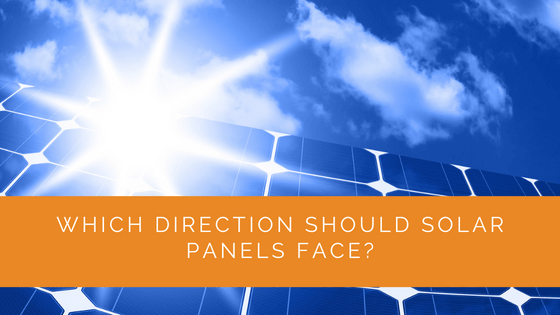The most spontaneous answer to this question would be – facing south. Deciding the placement of solar panels is not at all straightforward. A lot of factors go into determining where and how to place them.
The direction in which you place the solar panels affects how much energy they produce. If your home is located in the northern hemisphere, having the solar panels facing south makes the most sense. This placement ensures that the panels receive maximum sunlight.
Continue reading to learn which direction is feasible for placing your solar panels.
Contents
- 1 Key Takeaways
- 2 Is Your Roof Suitable for Solar Panels?
- 3 East-West V/S South Solar Placement
- 4 West Facing Solar Panels
- 5 The Best Solar Panel Direction
- 6 Case Study: Optimising Solar Panel Orientation for Maximum Energy Production
- 7 Expert Insights From Our Solar Panel Installers About Which Direction Solar Panels Should Face
- 8 Discover the Power of Solar with Solar Panels Network
- 9 Wrapping Up
Key Takeaways
- South-facing solar panels are the most effective direction for maximum energy production, especially in the northern hemisphere, as they receive the most sunlight.
- The suitability of your roof, including its orientation, shade, pitch, condition, materials, size, and any potential obstacles, plays a crucial role in determining the feasibility of solar panel installation.
- East-west facing panels or west-facing panels may be considered in specific situations, but south-facing panels are generally the best choice for optimal energy generation.
Is Your Roof Suitable for Solar Panels?
The first step is determining if your roof is suitable and ideal for a solar panel installation. Here’s what you need to consider for roof solar panel installation.
Roof Orientation
If yours is a south-facing roof, it is ideal for generating electricity at the best capacity. This solar panel system receives the sun from the best angle and when it is at its peak. However, for east-west facing roofs, there are still many scopes to generate electricity throughout the day.
Generally, a north-facing roof is not ideal for capturing solar power. Most solar companies recommend against north-facing solar panel orientation.
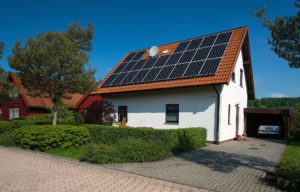
Roof Shade
A solar PV system can generate energy even if placed in the shade. Although, the quantity of energy produced will be reduced. Trees, neighbouring buildings, and electricity lines can add to shade.
If your roof has a lot of shadows cast on it, it might be a good idea to consider alternate solar options. It is best to get the advice of a solar installer to determine if an alternate solar power solution is required.
Roof Pitch
The presence or lack of slope of the roof affects solar production. Ordinarily, the roof pitch angle is usually between 30 and 40 degrees. If the PV system falls out of this range, it can still generate some power.
While flat solar panels can generate power, in some cases, the installer might recommend installing the panels at an angle.
The goal is to find the optimal angle to incline the solar panels to generate maximum output. The ideal angle is when the sun’s rays hit the panels perpendicularly because it generates more electricity.
Roof Condition
Before installing solar panels, a thorough check of the roof is required. If there is any damage or any holes present, it will all have to be fixed first. Solar panel systems are generally heavy, so ensure that the roof can carry its load.
Moreover, since solar panels are a significant investment in money and time, it is necessary to ensure that the roof is in the best condition.
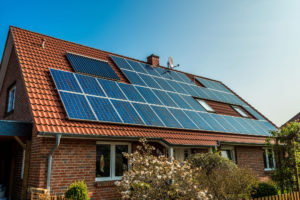
Roof Materials
Usually, glass roofs and thatched roofs are unsuitable for installing a PV system. The former cannot bear the load, and the latter carries a potential fire hazard.
Therefore, the roof material affects the installation costs and determines whether the roof can bear the load of solar panels.
Roof Size
A solar panel installation requires a clean roof space. The size of your solar PV system depends upon the roof size. Typically, a minimum of 4 panels are installed at a time. Otherwise, how many panels you install depends entirely on the roof size.
Roofs with skylights and roof vents may also obstruct the space for installing solar PV panels.
Any limitations or obstacles should be taken care of during the installation.
Roof Availability
Installation of PV systems does not require planning permission for domestic purposes. However, there are a few exceptions. You need planning permission if you have a flat roof or live in a listed building or a conserved area.
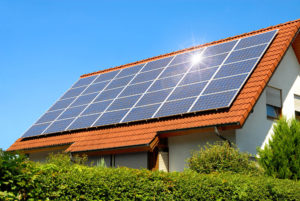
East-West V/S South Solar Placement
Let us first understand the sun’s movement in the sky to determine the direction of solar panels. The sun moves across the southern sky since we are in the northern hemisphere. Consequently, south-facing panels are exposed to maximum sunlight.
Shifting the angle slightly and placing the panels facing south-west or southeast can reduce energy production.
The roof orientation has an impact on solar panel production. To determine the solar ROI (Return on Investment), the cost of electricity has a more significant role than how much power the solar system can produce.
When considering east-west placement, you have three options for installing panels:
- On an east-facing roof
- On a west-facing roof
- Divide the solar array into two and let each half face east and west.
In the first option, the panels will receive sunlight during the first half of the day but will be in the shade for the rest. Similarly, for the second option, the panels will be in the shade for the first half but exposed to direct sunlight in the second half of the day. Finally, in the third option, half the panels will be in the shade, and the other half will receive sunlight for half the day and vice versa.
If you opt for any of the three east-west facing panels, you will require an additional optimising device to offset the effects of shade. While these devices improve energy production, they also significantly increase expenditure.
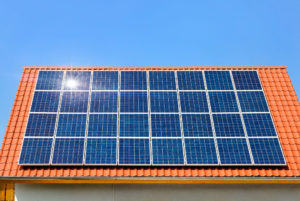
West Facing Solar Panels
West-facing panels are the best option if the utility company charges you based on a TOU or time-of-use structure. On the other hand, if they charge a standard rate, south-facing solar panels are the best option. It can help save on energy bills since you can rely on solar energy when the rates are high.
The Best Solar Panel Direction
We can safely conclude that the south-facing panels are the best direction. Here’s why:
- Most power is produced when the panels in the northern hemisphere are south-facing. This is because the sun shines directly over the equator. So, a south-facing solar panel can generate more electricity.
- You can generate surplus energy and store energy with a battery storage system.
Case Study: Optimising Solar Panel Orientation for Maximum Energy Production
Background
Solar Panels Network recently worked with a homeowner in Cambridgeshire eager to reduce energy costs and contribute to environmental sustainability. The challenge was that the property had an east-west facing roof, not the ideal south-facing orientation typically recommended for maximum solar energy production.
Project Overview
The project aimed to design and install a solar panel system that could efficiently harness solar energy despite the suboptimal roof orientation. Our team conducted a thorough site assessment to evaluate the roof’s potential and determine the best configuration to maximise energy output and financial savings.
Implementation
- Site Assessment and Feasibility Study: Evaluated the roof’s structure, shading patterns, and overall solar potential.
- System Design: Developed a 5kW solar PV system, split equally between the east and west-facing roofs. This design aimed to capture sunlight from the early morning to the late afternoon.
- Optimisation Equipment: Installed microinverters to ensure that each panel operated independently, minimising the impact of shading and orientation variations.
- Installation and Grid Connection: Completed the installation with secure mounting systems and connected the system to the grid, allowing for surplus energy export.
Results
- Energy Production: The system generated an impressive 4,800 kWh annually, despite the east-west orientation. This was achieved through careful planning and the use of optimisation equipment.
- Cost Savings: The homeowner experienced a 35% reduction in electricity bills. Additionally, the system’s ability to export surplus energy provided further financial benefits under the Smart Export Guarantee (SEG).
- Environmental Impact: The installation reduced the property’s carbon footprint, saving approximately 2.1 tonnes of CO2 emissions annually.
Summary
This case study demonstrates that even without a south-facing roof, homeowners can achieve significant energy savings and environmental benefits through well-planned solar panel installations. By employing strategic system design and optimisation technologies, Solar Panels Network ensured that the homeowner maximised their solar investment. The project showcases our commitment to providing customised, efficient, and sustainable energy solutions tailored to each client’s unique needs and circumstances.
Expert Insights From Our Solar Panel Installers About Which Direction Solar Panels Should Face
The south-facing orientation is optimal for solar panels in the UK because it maximises exposure to sunlight throughout the day. This positioning ensures the highest possible energy yield, making it the most efficient and cost-effective choice for homeowners.
Senior Solar Engineer
While south-facing panels are ideal, homeowners with east or west-facing roofs can still benefit significantly from solar energy. With proper planning and potentially using additional equipment like microinverters, we can optimise the system’s performance to make the most of available sunlight.
Solar Installation Specialist
It’s important to consider the unique characteristics of each property, such as roof pitch, shading, and space. A tailored approach can often overcome less-than-ideal orientations, ensuring that every solar panel system delivers the best possible return on investment.
Renewable Energy Consultant
Discover the Power of Solar with Solar Panels Network
Are you navigating the world of solar installations? Look no further than Solar Panels Network, the UK’s trusted partner in harnessing the sun’s potential. Our dedication goes beyond just installations; we’re on a mission to transform how homeowners and businesses across the UK perceive and utilise energy. By choosing us, you’re reducing your carbon footprint and making a smart financial move that promises savings for years ahead. Contact us today and embark on your solar journey.
Wrapping Up
South-facing solar panels produce maximum energy, especially in the northern hemisphere. Most homes have their solar PV system facing south since it produces the most energy. Additionally, south-facing panels receive sunlight for longer hours than those facing any other direction.
However, if south-facing solar panel orientation is not possible, it is not the end for your renewable energy goals. You can try adding more solar panels to generate more power.
Also, installing solar panels is significantly less and easily affordable; now that’s something to consider in good mind, right?
About the Author
Solar Panels Network stands at the forefront of solar energy solutions, driven by a team of seasoned solar engineers and energy consultants. With over decades of experience in delivering high-quality solar installations and maintenance, we are committed to promoting sustainable energy through customer-centric, tailored solutions. Our articles reflect this commitment, crafted collaboratively by experts to provide accurate, up-to-date insights into solar technology, ensuring our readers are well-informed and empowered in their solar energy decisions.

